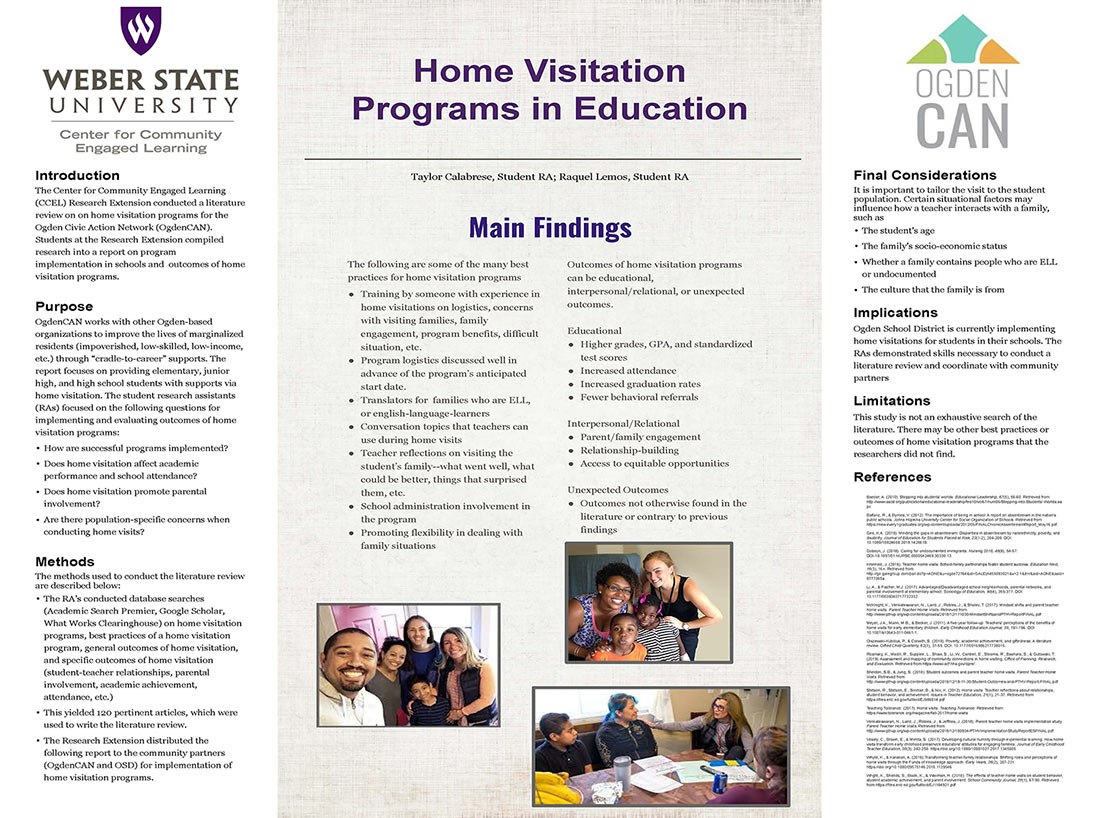
Home Visitation Programs in Education
The Center for Community Engaged Learning (CCEL) Research Extension conducted a literature review on home visitation programs for the Ogden Civic Action Network (OgdenCAN). Students at the Research Extension compiled research into a report on program implementation in schools and outcomes of home visitation programs.
Purpose
OgdenCAN works with other Ogden-based organizations to improve the lives of marginalized residents (impoverished, low-skilled, low-income, etc.) through “cradle-to-career” supports. The report focuses on providing elementary, junior high, and high school students with supports via home visitation. The student research assistants (RAs) focused on the following questions for implementing and evaluating outcomes of home visitation programs:
- How are successful programs implemented?
- Does home visitation affect academic performance and school attendance?
- Does home visitation promote parental involvement?
- Are there population-specific concerns when conducting home visits?
Methods
The methods used to conduct the literature review are described below:
- The RA’s conducted database searches (Academic Search Premier, Google Scholar, What Works Clearinghouse) on home visitation programs, best practices of a home visitation program, general outcomes of home visitation, and specific outcomes of home visitation (student-teacher relationships, parental involvement, academic achievement, attendance, etc.)
- This yielded 120 pertinent articles, which were used to write the literature review.
- The Research Extension distributed the following report to the community partners (OgdenCAN and OSD) for implementation of home visitation programs
Main Findings
Best Practices
The following are some of the many best practices for home visitation programs
- Training by someone with experience in home visitations on logistics concerns with visiting families, family engagement, program benefits, difficult situations, etc.
- Program logistics discussed well in advance of the program’s anticipated start date.
- Translators for families who are ELL, or English-language-learners
- Conversation topics that teachers can use during home visits
- Teacher reflections on visiting the student’s family--what went well, what could be better, things that surprised them, etc.
- School administration involvement in the program
- Promoting flexibility in dealing with family situations
Outcomes
Outcomes of home visitation programs can be educational, interpersonal/relational, or unexpected outcomes.
Educational
- Higher grades, GPA, and standardized test scores
- Increased attendance
- Increased graduation rates
- Fewer behavioral referrals
- Interpersonal/Relational
- Parent/family engagement
- Relationship-building
- Access to opportunities
Unexpected Outcomes
- Outcomes not otherwise found in the literature or contrary to previous findings
Final Considerations
It is important to tailor the visit to the student population. Certain situational factors may influence how a teacher interacts with a family, such as
- The student’s age
- The family’s socio-economic status
- Whether a family contains people who are ELL or undocumented
- The culture that the family is from
Back to Community Engagement Symposium

